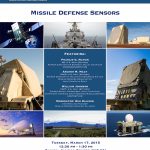On March 17, 2015 the Missile Defense Advocacy Alliance held a roundtable discussion on Missile Defense Sensors. The speakers provided a basic primer on the function of sensors in the current BMD system, types of sensors, and gave a candid perspective on the limitations of the current sensor system, and where the United States needs to invest to improve. On that aspect, the speakers emphasized the need on develop and deploy a Long Range Discrimination Radar in Alaska. Our featured speakers were
Rear Admiral (USN, ret) Archer Macy, former Director of the Joint Integrated Air and Missile Defense Organization;
Major General (USA, ret) Francis Mahon, Former NORAD/NORTHCOM Director for Strategy Policy and Plans;
Captain (USN, ret) William Johnson, Former Deputy Commander of the Joint Functional Component Command for Integrated Missile Defense
Riki Ellison, Chairman and Founder, MDAA
The key points made by MDAA’s expert panel included:
- Missile Defense Sensors play a role in every part of the BMD engagement cycle. The launch is first detected by overhead satellites, which detect the heat of the exhaust plume produced by the missile’s engine. These satellites then queue other radars, such as TPY-2, Upgraded Early Warning Radars, and sea-based SPY-1 radars to begin tracking the missile’s flight path. This information is used to predict where the missile is headed. As the missile continues its flight path, it begins to come apart as the warhead separates. Missile Defense sensors continue to track this “threat cluster” and discriminate between what is a lethal object and what is not. An interceptor is fired, and the tracking and discrimination data from the sensors is fed into the interceptor, which is guided to the target for the kill.
- From an operational perspective, the sensor system that exists today has some serious limitations. The Upgraded Early Warning Radars are good for tracking, but their lower L-Band frequency limits their discrimination ability. The S-Band SPY-1 Radars onboard Aegis do provide some discrimination, but these are multi-mission platforms in high demand, and are not always on station. Sea-Based X-Band Radar (SBX) provides excellent discrimination, but again is not always on station, and its narrow view requires that it receives queueing and tracing information from other sensors to acquire and discriminate the threat cluster. TPY-2 radars also provide good discrimination, but their locations often limit their contribution to the early phases of threat missile’s flight.
- Many of these shortcomings can be addressed by the development and deployment of a Long Range Discrimination Radar in Alaska. The LRDR would provide the persistent tracking and discrimination coverage in depth that the other systems lack, and unlike the SBX, would be able to do so without relying on queuing from other radar systems. The LRDR’s S-Band frequency would provide a balance between the long range tracking capability of L-Band Radars such as UEWR, and the high-fidelity discrimination capabilities of X-Band radars such as SBX. The LRDR would be able to handle future threats, as well the threats of today.


